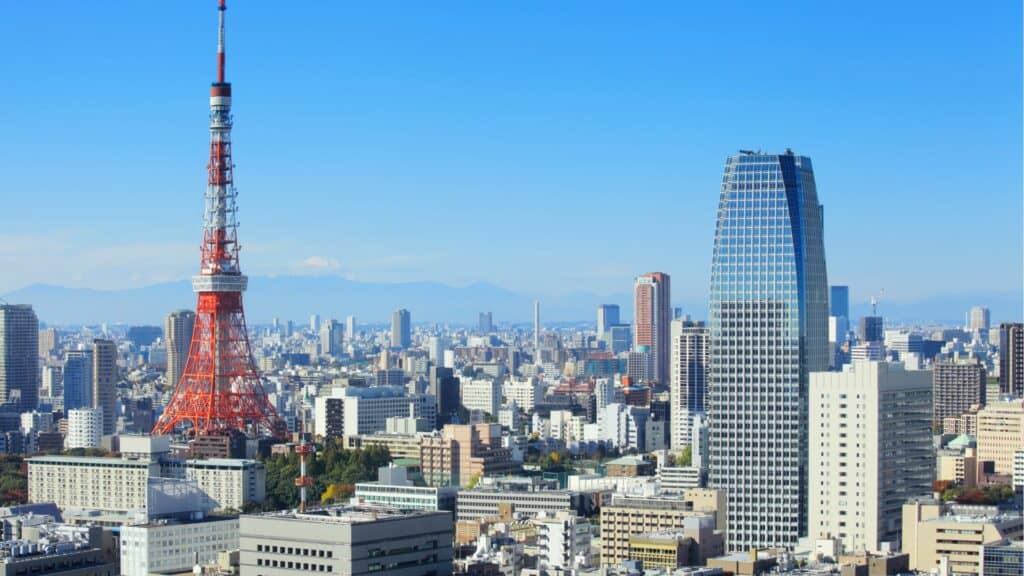The Tokyo Marathon stands as one of the world’s largest and most exciting marathons.
It features a fast and flat course, but it’s often considered one of the most challenging Six Marathon Majors to gain entry to.
With a limited international ballot and a notoriously demanding “semi-elite” entry option for those with qualifying times similar to Boston (sub-3.30 finish), approximately 320,000 runners enter the ballot for a chance at one of the 37,500 available slots.
In this blog post, we will cover everything you need to know about the Tokyo Marathon, from how to secure an entry to the associated costs and the eligibility criteria for participation.
Let’s get started…

When Is The Tokyo Marathon 2026
The Tokyo Marathon 2026 is scheduled to take place on Sunday, March 1, 2026. The course starts at the Tokyo Metropolitan Government Building and finishes near Tokyo Station.
How Much Does It Cost To Enter The Tokyo Marathon
The cost to enter the Tokyo Marathon varies depending on your residency:
1) Marathon:
- Japan residents: 16,500 JPY
- Overseas participants: 160 USD
2) 10.7km (6,6 miles) race:
- Japan residents: 5,600 JPY
- Overseas participants: 60 USD
Please note that these prices include entry fees, handling charges, and taxes. Additionally, overseas runners will now make their payments in US dollars.
When Do Entries Open For The 2026 Tokyo Marathon
The Tokyo Marathon 2026 offers multiple entry options with specific registration periods. Charity runner applications will be open from June 24 to July 9, 2025, with more details on the charity program coming soon.
Semi-elite athletes and ONE TOKYO GLOBAL members can register between August 1 and August 14, 2025, while general entry runs from August 15 to August 29, 2025. Those interested in volunteering can sign up between October 30 and November 24, 2025.
Who Can Participate In The Tokyo Marathon
The Tokyo Marathon offers various categories for participants, each with its own set of conditions and requirements. Here’s a breakdown of these categories and what’s needed to qualify for each:
For The Full Marathon:
(You must be 19 years and older on race day for you to be eligible for any of the following categories.)
- General Entry
This is the most common way to enter the Tokyo Marathon. You must complete the race within 6 hours and 30 minutes. In this category, you need to enter the lottery or ballot for a chance to secure a spot. It’s highly competitive, and entry is not guaranteed.
- Semi-Elite Athletes
To qualify for semi-elite entry, you need to meet the time standards specified by the “RUN as ONE – Tokyo Marathon.” Will dive more into this category later on.
- Elite Athletes
Elite entry is reserved for professional athletes registered with the JAAF in fiscal 2023 who meet special requirements set by the Japan Association of Athletics Federations (JAAF). Also, invited athletes nominated by the organizer and/or the JAAF.
- General Wheelchair
Must be capable of completing the race within 2 hours and 10 minutes using a racing wheelchair.
- Elite Wheelchair
Athletes registered with the Japan Para Athletics (JPA) in fiscal 2023, to be registered with the International Paralympic Committee (IPC) in fiscal 2025, meeting specific criteria.
For The 10.7km Race:
You must be at least 16 years old on the race day to qualify for any of the following categories.
- Junior & Youth
Runners between 16 and 18 years of age on the race day who can finish the race in 1 hour 45 min. Age restrictions don’t apply to those who have deferred their entry to this event.
This category may also include runners selected separately by the Tokyo Metropolitan Government under projects related to the Great East Japan Earthquake Recovery support.
- Visually Impaired
Must be capable of finishing the race within 1 hour 45 min.
- Intellectually Challenged
Must be capable of finishing the race within 1 hour 45 minutes.
- Transplant
Capable of finishing the race within 1 hour 45 minutes.
- Wheelchair
Must be capable of finishing the race in 40 minutes in a racing wheelchair.

About The RUN as ONE – Tokyo Marathon
The “RUN as ONE – Tokyo Marathon” program is designed for excellent runners who reside outside of Japan and meet specific criteria set forth by the Tokyo Marathon Foundation. Participants in this program are granted the right to participate in the Tokyo Marathon as “Semi-Elite.”
Eligibility
Applicants must achieve the following qualifying times in events that are either World Athletics Label Road Races or within a specified time frame:
Qualifying Times
- Men’s Full Marathon: Under 2 hours, 32 minutes, and 00 seconds
- Women’s Full Marathon: Under 3 hours, 19 minutes, and 00 seconds
These qualifying times are based on the gun (gross) time and applicants must submit an official finisher’s certificate.
Maximum Number of Entrants
The program allows for a maximum of 25 men and 25 women to participate in the Semi-Elite (Overseas) category.
Selection Process
If the total number of applicants exceeds the allotted field size for the Semi-Elite (Overseas) category, then those who are the fastest among the applicants will be accepted.
For applicants who are not accepted, their entry will automatically transfer to the General Entry category for further possible selection.
If you’re lucky enough to snag a spot in the Tokyo Marathon, congratulations! Now it’s time to prepare for the big day.
How To Train For The Tokyo Marathon
When you’re getting ready for the Tokyo Marathon, remember that it’s not just about running.
Your training is like a puzzle with different pieces that fit together to make your marathon plan. Each piece is crucial for your success.
Grab your Tokyo Marathon training plan here!
So, let’s break down these important parts.
Easy Runs
Easy runs are a fundamental part of your training plan, and the key is to keep them genuinely easy. That means you shouldn’t feel like you’re gasping for air; you should be able to chat with a running buddy comfortably.
These runs play a vital role in building up your aerobic system. This system helps provide your muscles with energy during less intense efforts.
Easy runs give your body a chance to heal, strengthen your muscles, and improve how your body uses energy.
During easy runs, it’s important to strike a balance. You want to challenge your aerobic capacity but also give your body time to recover before harder workouts.
Plus, easy runs have mental and psychological perks. They’re like a break from the more intense parts of your training.
You can enjoy the simple pleasure of running, reduce stress, and relax. It’s a time to clear your head, connect with nature, or chat with running pals.
The goal of easy runs isn’t to push your limits or break records. Instead, focus on keeping a steady effort and embrace the recovery and growth that happens during these runs.
Long Runs
Long runs are like the backbone of your training plan. They serve several key roles, but the big focus is on boosting your endurance and getting your muscles used to working for longer periods.
These runs are very important for getting your body ready to handle the demands of a marathon.
But that’s not all.
Long runs also help improve how efficiently you run. When you spend more time on your feet during these runs, your body gets stronger, your muscles learn to work together better, and your heart and lungs get in better shape.
This all adds up to you being able to run more comfortably, which is a big plus when it comes to your performance on race day.
Now, long runs aren’t just about getting your body used to running longer distances. They also give you a chance to try out different nutrition strategies. It’s like a testing ground to figure out what works best for you.
Strength Training & Conditioning
Strength training is like the secret sauce for runners who want to stay injury-free and perform their best.
One of the biggest perks of strength training is that it’s your personal bodyguard against injuries. See, when those little muscles aren’t doing their job right, the big ones have to step in, and that’s when things go haywire. Strength training gets everything working together smoothly, reducing the risk of injuries.
It’s not just about staying injury-free, though. Strength training can make you a more efficient runner. Depending on how you do it and how often, it can improve your running economy by 4% to 6%. This basically means you can run farther and faster with less effort, and you won’t run out of steam as quickly.
So, how often should you do this strength training stuff? Well, the golden rule is 2 to 3 sessions every week. It might sound like a lot, but it’s totally worth it. Plus, it helps prevent injuries and takes your performance up a notch.
Now, it’s not just about lifting weights randomly. It’s all about balance and timing. You need to blend strength training with your running plan. Think of it as the building blocks that make your running better.
Cross-training is another ace up your sleeve when you’re prepping for the Tokyo Marathon.
Since running can be tough on your muscles, cross-training lets you mix it up with activities that are kinder to your body. It’s like giving your muscles a little break while still keeping your cardio game strong.
Swimming, cycling, and elliptical workouts are great options. They get your heart pumping and your muscles working without all the pounding that running can bring. So, you get a well-rounded workout that supports your running goals.
Making sure you do the correct strength training is important. The good news is we’ve created a free strength training plan for runners that you can download by clicking here.
Rest Days
Recovery time isn’t something to shrug off either. Rest days might not be as glamorous as the actual running, but they’re the unsung heroes of your training plan.
Think of them as your body’s pit stops. They’re where all the magic happens. Your body gets the chance to adapt and grow stronger from all the hard work you put in during your training days.
So, make sure you give yourself that recovery time to come back even better and ace your next run. It’s all part of the master plan.

Tapering
Tapering is like the calm before the storm but in a good way! It’s that magical phase when you dial down the training volume right before the big race.
Sure, it might sound counterintuitive – you’ve been working so hard, and now you’re supposed to cut back? But trust us, it’s all part of the plan.
Tapering is your secret weapon to get your body in peak condition for race day. It’s all about reducing your mileage while keeping some training going. This helps your body recharge and get super strong for the marathon.
Don’t be anxious about cutting back – embrace the taper and get ready to shine on race day!
Nutrition
Marathon training isn’t just about running; it’s also about what you put in your belly. A balanced diet is your ticket to peak performance.
Your plate should be a colorful mix of whole grains, fruits, veggies, and protein. This way, you’re loading up on all the right vitamins and minerals your body needs.
Feeling like a zombie after your morning workouts? It might be because your post-workout food game is off. Training is bound to make you tired, but food is the secret weapon to fight that fatigue.
Entering the Tokyo Marathon may seem like a daunting task, but with the right preparation and research, anyone can do it.
Remember to check your eligibility, determine the entry costs, choose your method of entry, complete your application, and finally, prepare for the race day well in advance.
With these steps in mind, you’ll be well on your way to running through the streets of Tokyo in no time!



Comments are closed.